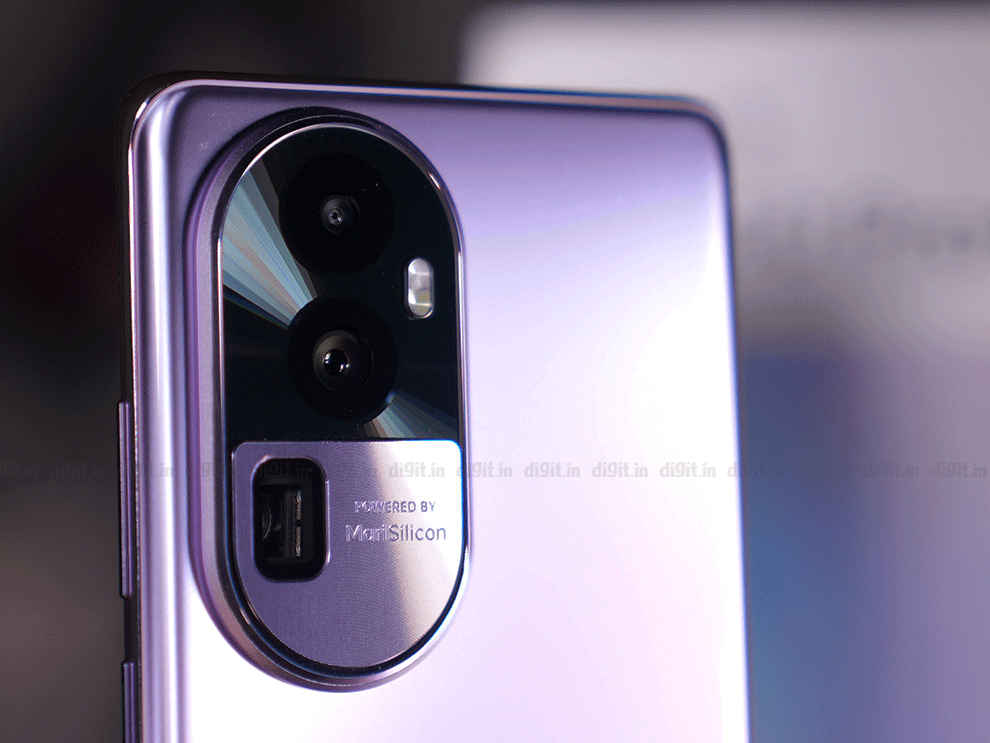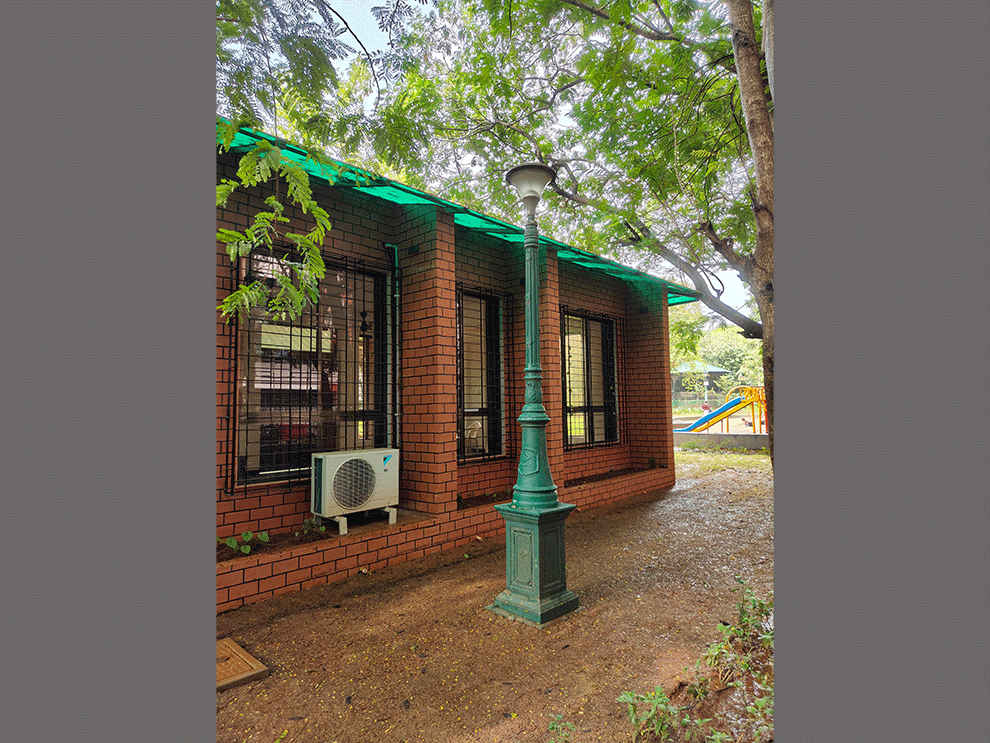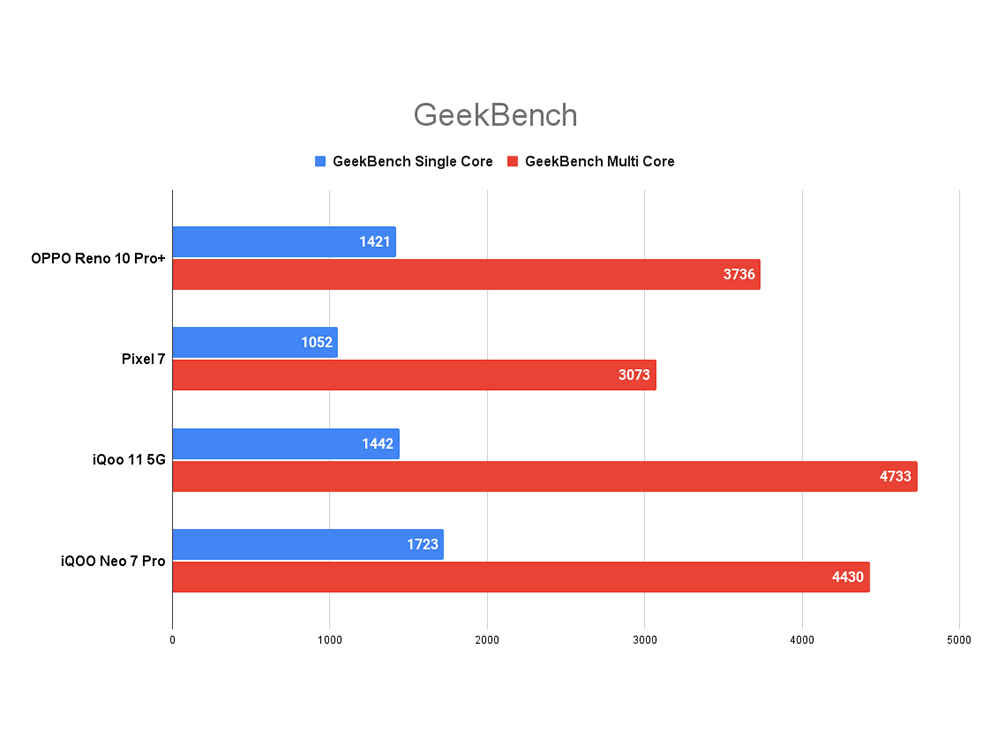OPPO made some tall claims with the OPPO Reno10 Pro+; the loftiest of which is being the “Portrait Expert”. I think they’ve actually nailed it to some extent. The telephoto periscope lens on the OPPO Reno10 Pro+ clicks some of the most stunning portraits I’ve ever seen. Especially at under ₹60K. The natural bokeh and crisp details make for some social-media-worthy shots, however, the camera system is not perfect. The portrait lens could use some tuning when it comes to skin tone colour and edge detection. Similarly, the primary lens could use some work on dynamic range; and the ultrawide camera needs a complete overhaul. However, it is a valiant attempt from the company. OPPO has truly managed to deliver a competitive portrait experience for a fraction of the price of competing flagship phones.
Touted to be the new “Portrait Expert” on the block, the OPPO Reno10 Pro+ 5G has finally launched in India to much fanfare. The company has made big claims about the Reno10 Pro+’s periscope telephoto lens’ portrait shooting abilities and at ₹54,999, there’s pressure to stay true to the claims. Moreover, the phone houses the Qualcomm Snapdragon 8+ Gen 1 SoC, which we’ve even seen on some mid-range contenders, so the camera has to knock it out of the park for this phone to be a good value proposition. This is the first Reno series phone we’re seeing from OPPO after a brief hiatus since the company did not launch the Reno9 series in India. So, naturally, I was excited to try out the Reno10 Pro+ to see how much of an improvement it is compared to the OPPO Reno8 Pro (which we reviewed) and how it stacks up against competitors. Let’s find out!
OPPO Reno10 Pro+ 5G Review: Build and design
The OPPO Reno10 Pro+ has a revamped design compared to the Reno9 and Reno8 series. There’s a new pill-shaped camera module; a massive design departure compared to the Reno8 and Reno9 series which had a rectangle camera module stuck to the top left of the phone. The new camera module looks striking; it definitely sets the phone apart and the module neatly incorporates all three lenses as well as the “Powered by MariSilicon” branding. This means it uses the same MariSilicon X chip as the Find X series. The module does jut out from the main frame considerably, meaning it will wobble on a flat surface.

The back panel is coated with Gorilla Glass 5 for protection and it has a shimmery effect that exudes a premium feel. The rear panel, however, is quite the fingerprint magnet; racking up substantial marks within seconds. The impression you get so far is that this is a premium device; well worth its ₹54,999 asking price when it comes to design, but that image shatters when you find out that OPPO has used a plastic frame for the phone, which is not really acceptable at this price.

The OPPO Reno10 Pro+ houses the charging port, a speaker, and the SIM tray at the bottom, and then there are the power and volume rockers on the right side. The top houses another speaker and the IR blaster (a welcome addition). The display is a beauty to look at with minimal bezels that are quite uniform. There’s an in-display optical fingerprint sensor that worked perfectly during our testing, but I would have preferred to have it higher on the screen as the stretch is a bit too much to reach it.

The phone is not IP rated and it comes with AGC Dragontrail Star 2 glass as protection for the display. OPPO claims this rivals the performance of the Corning Gorilla Glass 5, however, we haven’t tested its drop resistance. For a high-end device, OPPO has managed to keep it quite lightweight and slim making holding it extremely comfortable but the device is ridiculously slippery, so use it with a case. Thankfully, one has been provided right in the box.
OPPO Reno10 Pro+ 5G Review: Display and Sound
Sporting an OLED 10-bit colour display, the OPPO Reno10 Pro+ impresses with its immersive screen. The display sports a 1.5 K resolution (2772 x 1240 pixels) with 100 per cent P3 wide colour gamut and support for HDR10+. I would have preferred 2K resolution but 1.5K is pretty crisp as well. HDR works seamlessly on YouTube and Amazon Prime with stunning, vivid colours; but it is missing on Netflix, so far.

There’s ProXDR support that bumps up the contrast and dynamic range of HDR photos viewed on the Reno10 Pro+ that make them look even more spectacular. The display also supports 120 Hz refresh rate with an option for Dynamic refresh rate that switches between 45, 60, 90, and 120 Hz as per the requirements to conserve battery life. All good things, but when I select High refresh rate (120 Hz), apps such as Instagram and Twitter still default to 90 Hz. Why OPPO, why? Don't market it as a 120 Hz phone then!
That aside, the display looks beautiful, HDR content looks stunning with decent detail and great colour. The viewing angles are fantastic and the display is bright enough to be legible even in bright sunlight. OPPO has rated it at 1100 nits of peak brightness on High Brightness Mode and in my testing, I got a peak brightness reading of 992 nits, which is close enough.

The display’s incredible 90.6 per cent screen-to-body ratio makes the content look even more immersive; honestly, it engulfs you in a visual paradise. The addition of Dual Track stereo speakers – one at the bottom and one at the top, makes for an upgraded content consumption experience. The speakers are loud, carry the heft in the bass region, and don’t sound tinny – which is usually the overarching problem in smartphone speakers.
OPPO Reno10 Pro+ 5G Review: Camera
In the marketing campaign of the OPPO Reno10 Pro+, the company has made it abundantly clear that they are positioning this device as the camera-first experience – hence the tradeoffs in other areas – Snapdragon 8+ Gen 1 instead of 8 Gen 2, LPDDR5 RAM instead of LPDDR5X and more. “The Portrait Expert” is the tagline, and well, for its asking price of ₹54,999, this is one of the best portrait phones in its segment. OPPO has finally brought back the telephoto periscope lens on a Reno phone after many years, which is fantastic news. But, it’s not perfect, I’ll explain more later. Let’s first start with the specs of the camera system.

The OPPO Reno 10 Pro+ 5G comes packing a 50 MP Sony IMX890 primary camera with f/1.8 aperture and OIS. There’s a 64 MP OV64B ½-inch periscope telephoto lens with 3x optical zoom and 6x optical-quality in-sensor zoom. This is a very large sensor for a telephoto camera, which should provide you with great low-light results and a natural-looking bokeh effect. You can also zoom all the way up to 120x digitally too! To complete the trio of rear lenses, you’ve got a humble 8 MP ultrawide shooter with 112-degree FOV. The company has also packed a 32 MP Sony IMX709 selfie camera with AutoFocus technology.
The primary 50 MP camera is capable of clicking some good shots with saturated colours and great detail. However, the dynamic range is not the best in the business. Highlights can get overblown at times, and we’ve seen some object haloing happen in tricky lighting situations. OPPO tries to retain detail in the shadows in most pictures, but the algorithm sometimes messes up the highlights in the process. Still, we're nitpicking, and in most cases, you’re going to get a detailed, social-media-ready picture. We've attached photo samples below, but do note, they've been compressed for the web.



The telephoto periscope lens is where all the magic happens. The 3x magnification level especially coughs up some stellar results with great detail retention, decent colours, and good dynamic range. The bokeh looks superb and you can adjust it to your liking after clicking the picture as well. The telephoto lens even delivers awesome portrait results on inanimate objects, such as the golden fence below. Sadly, it is not all perfect. The telephoto lens has the tendency to wash out skin tones at times; it makes some subjects’ skin tone lighter than it is. Additionally, the edge detection is not top-tier level. If OPPO manages to fix these issues via a software update, this can easily be one of the “Portrait Experts” that even competes with ₹80K-1lakh+ phones.



Now, the portrait lens also offers 6x in-sensor lossless zoom and the quality this offers despite not actually being a 100 per cent optical zoom is incredible. Crisp details, great colours, and fantastic bokeh blur is what you get at even 6x zoom levels!

6x in-sensor zoom sample
The 8 MP ultrawide lens feels like a misfit when compared to the other two stellar lenses. It is decent, no doubt, but the images are noticeably softer, distorted around the edges, and lack good dynamic range. Not only are some shadows crushed, but some highlights get overblown too.

We also tried our hand with low-light photography, and as expected, the ultrawide lens was the weakest link with soft, grainy results. The 50 MP primary lens manages to capture good detail in Night Mode with very little noise. The samples below are in low lit conditions and they look fantastic and usable without any editing needed.


Portrait 3x shots in low light, however, are inconsistent. Do note that in low light conditions, the telephoto lens is disabled and instead, the primary camera digitally crops to 3x or 6x shots. So, look at the difference between these two portrait shots taken in low light, one after another. The lens can’t seem to figure out the exposure right. Also, it gets the edge detection very wrong in low-light, at times. However, we’re hoping OPPO can, yet again, nip some of these issues in the bud via OTA updates. Time will tell, and we’ll update the review!


Lastly, let’s delve into the 32 MP selfie camera. This is actually my second favourite lens on the OPPO Reno10 Pro+ after the periscope telephoto lens. I was impressed with the level of detail in selfies and how OPPO actually stayed true to the skin tones of individuals. The dynamic range is also impressive! Portrait selfies, however, while being crisp and detailed, have mediocre edge detection. This is something OPPO really needs to work on. Also, at times, the selfie camera's Auto-HDR can overprocess the pictures.

Video recording tops at 4K at 60 fps and the footage is decent, nothing revolutionary. Selfie video is capped at 1080p, which is a shame since the processor is capable of 4K selfie videos.
Overall, the OPPO Reno10 Pro+ 5G has all the hallmarks of being a fantastic camera-centric smartphone. There are just a few hitches that need to be ironed out, and you could have a winning camera formula capable of competing with the flagships without actually sporting a truly flagship price tag. In the ₹50K-₹60K price range though, the OPPO Reno10 Pro+ provides stiff competition to the likes of the Google Pixel 7!
OPPO Reno10 Pro+ 5G Review: Performance
The OPPO Reno10 Pro+ 5G is powered by the Qualcomm Snapdragon 8+ Gen 1 SoC which is manufactured on the 4 nm process. There's only one variant which comes with 12 GB LPDDR5 RAM and 256 GB UFS 3.1 storage. No expandable memory. Now, despite being a top-of-the-line SoC that was launched just last year, OPPO has already faced some flak regarding their decision to use this chipset. This is because cheaper phones such as the iQOO Neo 7 Pro and the OnePlus 11R (review) also sport this chipset. Naturally, consumers feel that at ₹54,999, Snapdragon 8 Gen 2 or MediaTek Dimensity 9200 SoCs are warranted.

As a result of this, the OPPO Reno10 Pro+ is not the best performer in its price category. In fact, the iQOO Neo 7 Pro that costs just ₹34,999 - that’s ₹20K cheaper - outperforms the Reno10 Pro+ in almost every benchmark. Let’s see what the tests say.
In AnTuTu and GeekBench, the iQOO 11 (review) and iQOO Neo 7 Pro outperform the Reno10 Pro+ but the Pixel 7 (review) lags behind. Interestingly, the iQOO Neo 7 Pro which is powered by the same chipset as the Reno10 Pro+ performs considerably better in these two benchmarks. This could be because OPPO is throttling the performance to some extent to boost device longevity and reduce heat. We ran the CPU Throttling Test to check this, and in less than 20 minutes, the OPPO Reno10 Pro+ had already throttled to 78 per cent of its peak performance. The phone doesn’t heat too much though, possibly due to the upgraded cooling system.



In PCMark Work, the Reno10 Pro+ puts up a valiant effort beating out every phone but the iQOO 11, which means it will serve you well for productivity tasks such as working on excel sheets, editing photos, and more.

In GPU benchmarks, the OPPO Reno10 Pro+ performs decently, beating out the iQOO Neo 7 Pro but falling behind the Snapdragon 8 Gen 2-powered iQOO 11. In GFXBench, both the iQOO Neo 7 Pro and the iQOO 11 are significantly ahead.


In real-life, you’re not going to see any considerable stutters or hitches in daily use. Performance is smooth, lag-free and pretty speedy. You can also play heavy duty games such as Call of Duty: Mobile and BGMI at high graphics and high frame rate without too many frame drops. However, Genshin Impact does tax the phone after about 15 minutes, and you will start to see some frame skips. Overall, a decent performer, but not the best at this price (or lower), for sure.
The OPPO Reno10 Pro+ ships with ColorOS 13.1 out of the box based on the latest Android 13. OPPO has promised three years of OS updates and four years of security updates, which matches Google phones but falls short of Samsung ones. The UI, as we’ve seen on other OPPO phones, is feature-rich; packed with customisability. However, the bloatware is so rife that we were dissuaded from the fact that this is a high-end, near flagship phone.
There are numerous preinstalled apps and a galore of OPPO apps, some of which can’t be uninstalled. Additionally, there was this annoying non-dismissable setup notification that went ahead and installed 11 apps (including Paytm, Google Lens, and a bunch of absurd games such as Block Blast Adventure Master and Crowd Rush 3D). All without my explicit consent. For a ₹55K phone, the customer has already paid enough. They don’t have to pay further with their time. Time that would be needed to manually uninstall these unwanted apps.
OPPO Reno10 Pro+ 5G Review: Battery life
The OPPO Reno10 Pro+ houses a 4,700 mAh battery to keep the lights on. While on-screen time was pretty decent in my testing, the phone leached quite a bit of battery on standby. Going from 80 per cent at 8 PM at night to 2 per cent at 10 AM in the morning. In my 4K video loop test, the phone lasted a decent 14 hours and 12 minutes, which is not bad. The battery life is decent enough to last most users an entire day, but this is a phone you’d have to charge every night. Additionally, if you’re a heavy user, you may find yourself reaching for the charger at 6-7 PM in the evening.

Either way, the battery life is not appalling but it’s not the best either. However, the 100 W SUPERVOOC fast charging support kind of makes up for it. The phone goes from 0-100 in just 29 minutes, according to my tests. Furthermore, a mere 5 minute charge top you up to around 20 percent or even more, which is impressive. Sadly, there’s no wireless charging, even though the back panel is glass.
OPPO Reno10 Pro+ 5G Review: Verdict
OPPO made some tall claims with the OPPO Reno10 Pro+; the loftiest of which is being the “Portrait Expert”. I think they’ve actually nailed it to some extent. The telephoto periscope lens on the OPPO Reno10 Pro+ clicks some of the most stunning portraits I’ve ever seen. Especially at under ₹60K. The natural bokeh and crisp details make for some social-media-worthy shots, however, the camera system is not perfect. The portrait lens could use some tuning when it comes to skin tone colour and edge detection. Similarly, the primary lens could use some work on dynamic range; and the ultrawide camera needs a complete overhaul. However, it is a valiant attempt from the company. OPPO has truly managed to deliver a competitive portrait experience for a fraction of the price of competing flagship phones.

That aside, I think there are some other areas where the OPPO Reno10 Pro+ could really improve. Some examples are the plastic frame at ₹55K, inconsistencies in the refresh rate settings, and the bloatware-ridden ColorOS. Additionally, for gamers, this is not the most powerful offering at this price and for 15-20K cheaper, you can get phones that sport the same SoC. Personally, I cannot wait for the OPPO Reno11 series. I hope the company takes what’s bad and makes it better, but more importantly, takes what’s good and makes it spectacular.
from Mobile Phones Reviews https://ift.tt/8i3vdkb



































